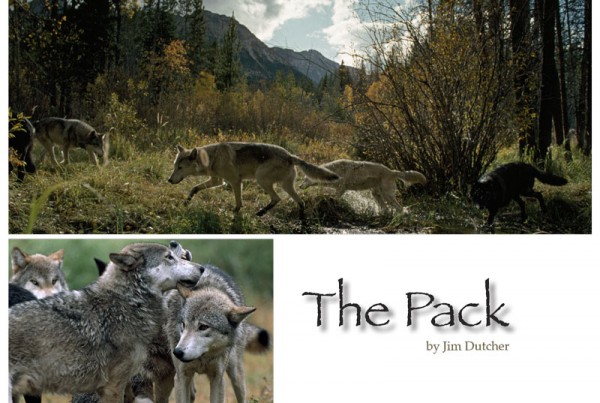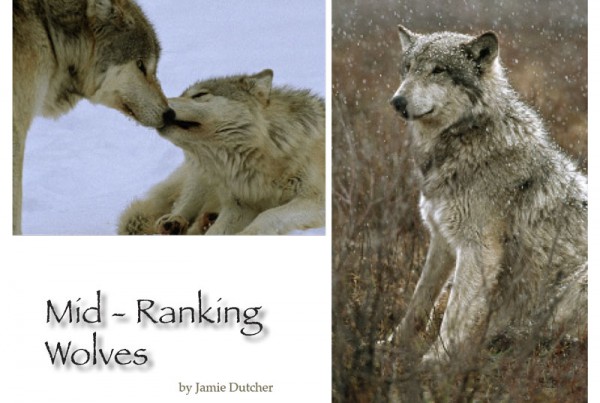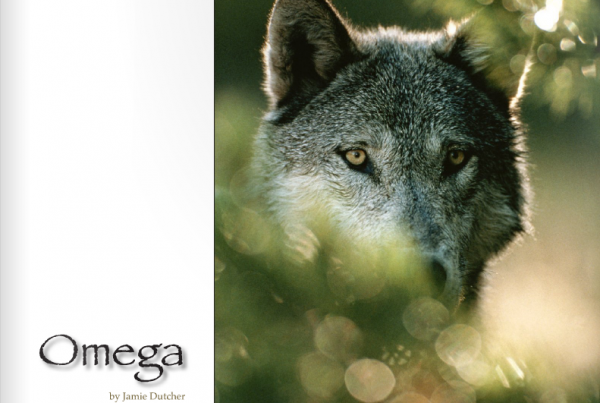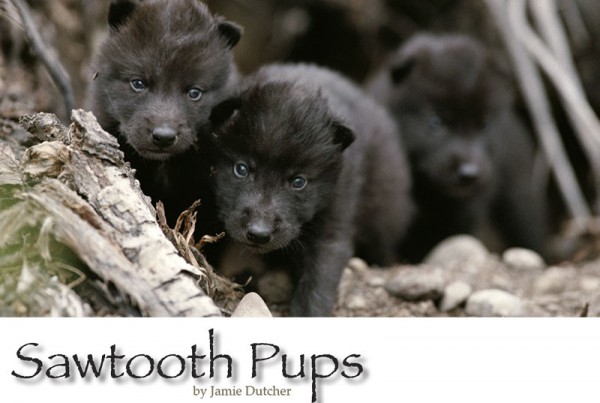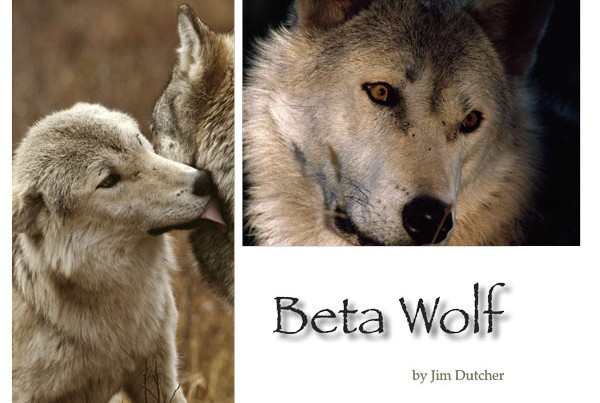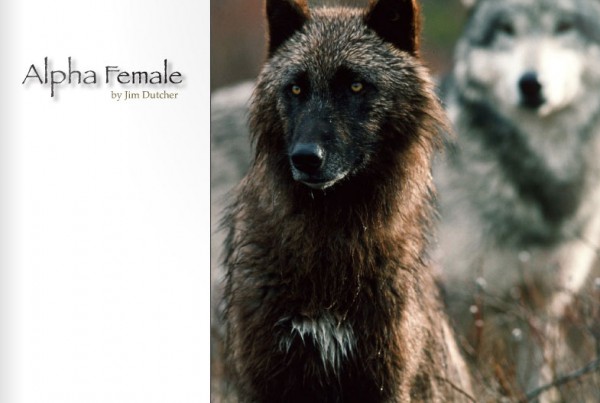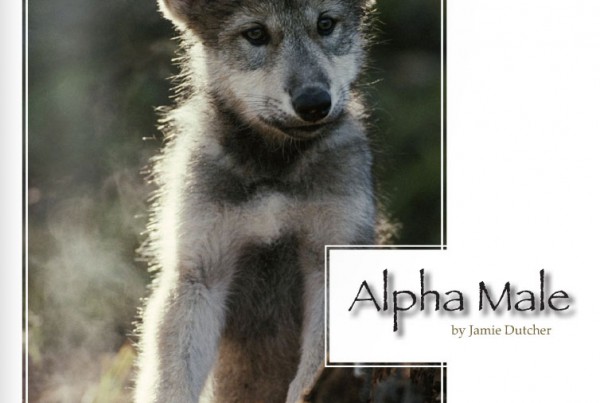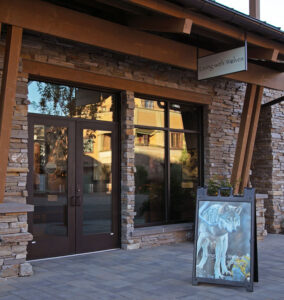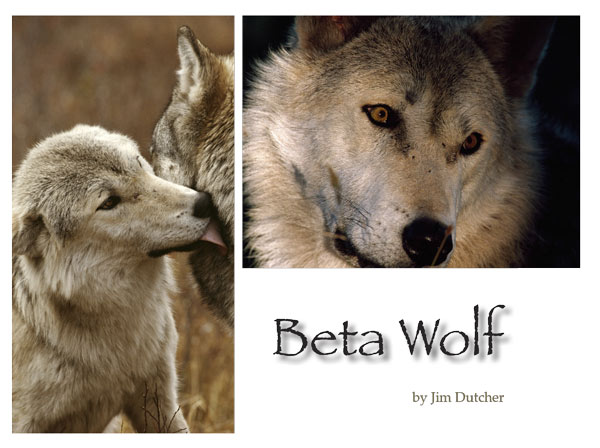 Thus, in the early years of the project when we introduced three pups, one male and two females, to the existing pack of five adult males, we knew we were creating a much more complicated society and one that more accurately mirrored a wild pack. Previously unseen personality traits surfaced as each wolf responded to the new pups in his own special way. The most dramatic of these was Matsi.
Thus, in the early years of the project when we introduced three pups, one male and two females, to the existing pack of five adult males, we knew we were creating a much more complicated society and one that more accurately mirrored a wild pack. Previously unseen personality traits surfaced as each wolf responded to the new pups in his own special way. The most dramatic of these was Matsi.
Matsi was the littermate of Motomo and Amani, born in 1992 to the same parents that had given birth to Kamots and Lakota a year earlier. In a perfect example of how variable wolf markings can be, these three siblings ranged from Motomo’s coal black coat, to Amani’s traditional gray and black, to Matsi’s uniform beige coloration and complete lack of darker facial markings. Because of his sunny appearance we gave him the Blackfoot name for “Sweet and Brave.” Throughout his entire life, Matsi lived up to that name.
Not much is written about betas, and their role in the pack structure is unclear when compared with the well-defined positions of alpha and omega.
In the very simplest of terms, the beta male is the “second in command,” dominant over all but the alpha.
While the positions of mid-ranking wolves are somewhat fluid, the beta generally enjoys a more stable existence. Since there is something of a separate hierarchy for males and females, there will generally be a beta female as well as a beta male.
Most scientists suggest that the beta male will assume command of the pack if the current alpha is killed or injured. For this reason, a beta may have to perform the most delicate balancing act of any wolf in the society. Matsi was certainly the gentlest wolf in the Sawtooth Pack, both to me and to his pack-mates. It could well be that his kindness was a way of garnering support in case his time ever came to be the alpha. In my observations, however, Matsi seemed completely uninterested in social rank. While Amani and Motomo jostled for position, Matsi conducted himself in a fashion similar to that of Kamots.
Back when he was a yearling, things had been somewhat different. Matsi had been fairly aggressive and seemed intent on asserting himself, especially over his brothers. When he was barely a year old, Matsi helped to solidify Lakota’s omega status. It seemed as though he set out to prove himself to his elders and to secure a dominant role in the pack early on. Once his beta position was firmly established, Matsi relaxed, becoming one of the least aggressive wolves in the pack. He seemed to know which rank suited him.
Matsi possessed an intangible quality that I still find difficult to describe. In all affairs, he conducted himself with an air of calm dignity. He never seemed too concerned with what we humans were up to, but he did seem to enjoy our company. Often he sat quietly by my side, never expecting anything, not trying to solicit attention, just spending time with me as a friend, an equal, and I respected him for that.
There are two occasions when the social structure of a wolf pack is most apparent. The most volatile time is during the breeding season when the dominant males and females aggressively demonstrate their status.
The other time that brings out the fiercest demonstrations of social rank is feeding. Much of the footage of dominance and submission that went into my films was shot on or around a deer or elk carcass. As I had learned to do earlier, I shot a great deal of this footage in slow motion so it would better reveal subtle nuances of the wolves’ behavior.
Kamots’ favor seemed to shift regularly. Some days he would let some of his pack eat immediately, some days he would make them wait. But one factor remained constant: Matsi was always allowed to eat with Kamots. This is not to say that he was not cautious. Like the other subordinate wolves, he selected a spot far away from Kamots and kept his eyes on the alpha as he ate, but he never doubted his place at a kill.
It was during feeding that Matsi’s reputation as a peace-maker was born.
As the meal progressed and more and more of the deer disappeared, Motomo and Amani would become increasingly agitated. Frequently they would work out their frustration on the unfortunate Lakota who was always waiting in the wings, torn between the desire to snatch a bite of food and the fear of drawing attention to himself.
Once as I was filming, I watched Lakota give in to his hunger and try to pick up a morsel that had been flung aside. Upholding the pecking order, Matsi growled and chased Lakota several feet away from the kill and then returned to his meal. Amani, still waiting for his turn to feed and anxious to make a show of prowess, took over where Matsi had left off. He turned toward Lakota with a growl and tackled the confused omega, flipping him onto his back and straddling him as he often did. To our surprise and perhaps even Lakota’s, Matsi again left the kill but this time he rushed at Amani, knocking him off Lakota. Matsi was disciplining Amani for disciplining Lakota.
We thought at the time that this was a fluke, that Matsi was simply displaying a lot of dominance that day. The more we screened our slow motion footage, the more we realized that this was a pattern. Matsi was continually sticking up for Lakota. One particular roll of film that I had shot of a pack rally was the first to bring our attention to Matsi’s peacekeeping ability. The rally was especially energetic and had turned sour on Lakota. Perhaps he had joined in the howl too enthusiastically or howled too well. Or perhaps one of the mid-ranking wolves just felt the need to assert his dominance. Whatever the reason, the pack had formed a mob around the hapless omega, blocking his escape. Even the yearlings Wahots, Wyakin and Chemukh were old enough by this time to get involved in the action, not really harassing Lakota but nevertheless adding to the mayhem. As always, Amani was the main perpetrator of any aggression aimed at Lakota. He closed in on the omega, climbing on his back and nipping at his flanks while Lakota sunk to the ground and tried to worm-crawl his way out of the ring.
A moment later Matsi charged into the fray as well. When I filmed this action, I assumed that Matsi was simply abusing Lakota with the others. It was Jamie who observed during the third or fourth screening of the footage what we had failed to see in the blur of fangs and fur. Matsi was not digging into Lakota, rather he was forcibly inserting himself between Lakota and his tormenters.
In effect, he was body-checking Amani out of the way, giving Lakota the opportunity to make a dash for cover.
We were never able to explain the special bond that Matsi developed with Lakota. If we had tried to look at it with a purely scientific eye, it would have been very hard to see what Matsi got out of it. Their relationship was especially surprising because Matsi had played such a huge role in forcing Lakota into the omega position to begin with. Once the ranks were established, however, Matsi was extremely gentle with the omega.
As adults, the two often slept side by side, and when Matsi went exploring Lakota often joined him. At the very least, Lakota knew Matsi to be the one wolf who would not pick on him and might even offer him some protection, but there seemed to be more to it than that. Matsi genuinely seemed to enjoy Lakota’s company. With Matsi, Lakota was free to do things he wouldn’t dare do around the others. He would never have jumped on Amani or Motomo’s back to instigate play. No wolf, not even benevolent Kamots, would have stood for that sort of audacity from an omega. Matsi, on the other hand, let it pass. He actually appeared to enjoy it, since he nearly always took the bait and launched into a mock fight or game of chase with Lakota. One of the happiest sights I have experienced in all my time with the pack was the sight of these two frolicking together and the look of joy on Lakota’s face, freed for a moment from his burdens.
Could it be that Matsi was simply showing his care for Lakota, understanding how the omega suffered and offering a moment of relief? Though it is difficult to observe such subtle behavior in the wild, indications of this kind of care do exist. While we were on location in Fairbanks, Alaska, a biologist showed us the skull of an average sized male wolf. The skull bore unmistakable evidence that the wolf had suffered a broken jaw in his lifetime, probably delivered by the kick of a moose or caribou. Such an injury would have rendered the wolf unable to hunt or even tear hunks of meat from a kill. Yet the skull indicated that the bone had mended and the wolf had continued to live for several years. The only way he could have survived this injury is for the other wolves of his pack to feed him. They would have had to bring food to him from a kill, possibly even regurgitating for him, nurturing him as they would a pup.
Observing Matsi’s behavior, I genuinely felt that if one of the Sawtooth Pack were injured he would be the one to take charge of the nursing and care.
The survival of the pack seemed that important to him. Of course, this also meant that the rules of society were important to him as well. Although Matsi was more than willing to let the social order bend, he was by no means willing to let it break. I don’t recall seeing Lakota behave as freely with Matsi when they were in the company of Kamots and the others. Perhaps Lakota didn’t want to attract attention to himself, or it may have been that Matsi would not tolerate the same liberties in public. Matsi certainly wasn’t going to budge an inch when it came to food. If Lakota overstepped his bounds at mealtime, Matsi was quick to make his displeasure known.
One day, as I was photographing the pack, I noticed Lakota cowering under a tree. He was tucked into a deep crouch with his ears plastered back, looking as if he were trying to be absorbed by the ground and disappear. As I watched him and wondered what he had done, Matsi walked up to Lakota, lifted his leg, and urinated all over the unfortunate wolf’s back. I had missed whatever earlier altercation had provoked this extreme demonstration of dominance but it was clear that Matsi felt the need to put Lakota severely in his place. I was so shocked at the behavior that I was too dumfounded to squeeze off a photo. That afternoon, however, I spied the two playing by the pond together and that night they slept side by side.
I have often said that Kamots’ confidence is what made him such a superb leader. Although Matsi did not have the drive to lead the pack he did seem to possess some of that same confidence. One of the reasons Motomo and Amani were quick to pick on Lakota was because they themselves were insecure in their status and felt they had to make a show of dominance. Matsi just didn’t feel the need. He knew exactly where he stood.
As I look back on my years with the Sawtooth Pack, I see Matsi as the embodiment of all that was magical about them. He was a wolf that gave everything of himself for the benefit of the pack. He patrolled their territory, took care of the pups, maintained peace and order – and amidst all this, he seemed completely content not to rule. Matsi taught me that the workings of a wolf society are deeper and more complex than I will ever know.
Although competition is prevalent and the drive to become the alpha can burn fiercely in the hearts of certain wolves, the good of the pack, the family, is more important than anything.
Scientists are continually debating the emotional life of animals and only lately has real consideration been given to the possibility that a creature like a wolf could be capable of something as complex as compassion. If compassion is not a word that can be used to describe a wolf, then what word should we use? What word would a wolf use when it protects the omega from aggression, or when (as has been observed in Alaska) it brings food to an injured pack mate? When a worried mother brings her sick child to the doctor, no one would suggest that it is because she knows the child carries her genes, or that she wants the child to care for her when she is older. I have yet to see a shred of evidence that humans have a monopoly on feelings.
This insight is the gift that Matsi gave to me. It has been an underlying theme in my films and the single most important message about wolves that I can share. They possess something beyond their more obvious attributes of beauty, strength and intelligence. These animals, who have been maligned for centuries, despised as the embodiment of all that is cowardly, savage, and cruel, clearly care about one another and show signs of what I would call nothing less than empathy and compassion.

